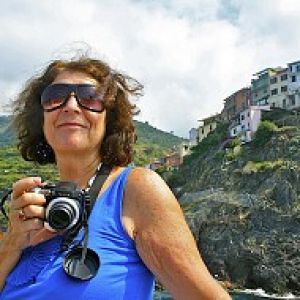Djemila Roman City
Today we set off at 7.45 am as we had 360km to Constantine with Police escort. Every 30 mins or so there would be a seamless changeover. Our escort would pull into the hard shoulder and the next car would appear, the 2 officers would take the details of our journey and on we went in convoy. At least 20 units were involved it getting us to Constantine. The motorway was 3 lanes each way because it ran to Setif, the large port and commercial centre.
While on the road M’hamet gave us some geographical information. (Skip this as it’ll be on Google, but it’s my diary). Algeria, now the biggest country in Africa (in fact bigger than Greenland though it doesn’t look it on the map), has 4 geographical regions.
1 Tell is the most fertile region and is parallel to the coast - it gets rain water for the crops and it is stored in reservoirs.
2 Tell Atlas - green area running from
Morocco then the separation between it and next region is drier and more rocky
3 - high plateau drier heading further south with hot summer 45-50 Winter v cold. Still some agricultural - barley wheat
4 - Sahara is 90% desert. Biggest hot desert (Antarctica is biggest desert).
Sahara here can divide in Erg (sand dunes and flat and arid) but some products are still grown eg - dates and water melon. Here water comes from underground - that nearest surface and also from the algian sea. This water system is the biggest in the world but only the govt can extract from such depth. But due to the climate crisis, lack of rain means this resource is threatened as fracking gas is being talked of but this wouldn’t be good because it’s a threat for the water. And example is theyOasis in Gardaia. Further south is the other part of the fourth region, the occidental Erg which is from Timmimoun south, the biggest 78000 km of sand sea.
Next we had a short talk on the history of
Setif, which is not only the commercial centre now but is also famous as the place where the historic revolution started.
(Again it’s to remind me and most likely of no interest).
In 1832 the French (after Ottoman period) promised equality and justice. They made Algeria a French dept and Algerians French in 1865. However French nationality did not come with citizenship for all. Only Jewish people got it because they were important for the economy. But this was abolished during the Vichy times in WW2. So the promised equality still did not materialise as on 8 May 1945 Jewish inhabitants got citizenship again. Arabs were promised by the French to get equal rights for taking part in the war. But it when that didn’t come there was the Martyrs’ revolt. As the French were allowed guns, 45,000 died, hence Sitif, where the uprising started, is a symbol of the martyrs struggle. This led to the 1954 revolution started by young activists wanting equality. The war ended in 1963, when Algeria succeeded in gaining independence.
After 3 hours we reached Djemila where we had a lunch of salad, bread, delicious lentil soup and chicken and couscous. I had a bit of couscous which was served with a watery tomato sauce. We had bits of juicy honeydew melon and watermelon to finish.
The cafe was close to the entrance of Djemila Roman ruins, a UNESCO World Heritage site, at one time a city of around 45.000 people. He told us about the 3 Punic wars. (If like me you did Latin at school you’ll have heard enough of them). Algeria was important because it provided wheat for Rome. Around 146BCE after the 3rd Punic war Carthage was defeated and Berber tribes sided with Julius Caesar and the Citra became Constantine. Djemila became one of the ex nova colonies and Algeria had 5 centuries of Romas rule before the arrival of the Vandals.
The site was huge - I did over 8000 steps down, round and up in a sunny 82 degrees. I’m so glad I didn’t bother with the casbah yesterday as I was able to do it all today. I’m sure I’ll suffer tomorrow when there’s a steeper site. We made our way first to the museum which had 4 rooms of fabulous mosaics from floor to ceiling - they came only from this site, from some of the floors of large houses. We didn’t get long enough really to take our time looking before we had to set off walking down to the city. We saw the theatre, temples, market place, gym, baths, houses and the important Caracalla Arch from 216CE. In the agora we saw several Mensa where goods were measured out and at the side was the cubit measure. I’d not seen those tables anywhere before.
On the way back up the hill we saw the only Meta sudens in the world. There had been another sweating fountain in Rome but it was destroyed - it was in the way of the route of a Fascist parade. The water was pumped up then as it spills over the top of a cylinder shape about 20 feet high it looks like the fountain is sweating. In a circle round it was a wall to keep the water in a pool. The stones surrounding it were worn away by the heads of animals as they leaned over to drink.
We got to Novotel in Constantine just before 7, had dinner at 7.30. Salad mainly as not much available for veggies.
- 39
- 0

Comments
Sign in or get an account to comment.


